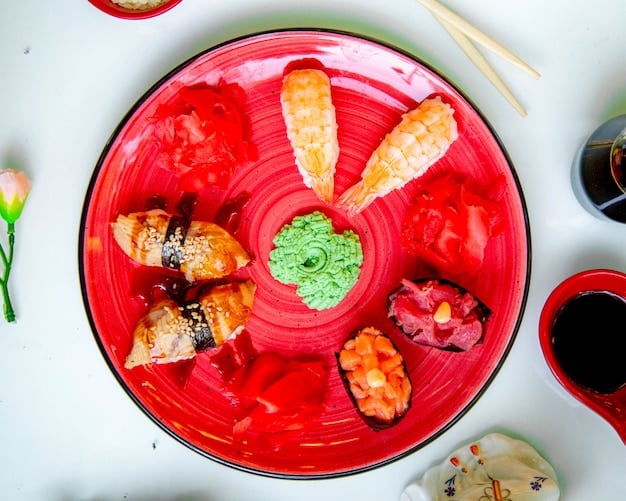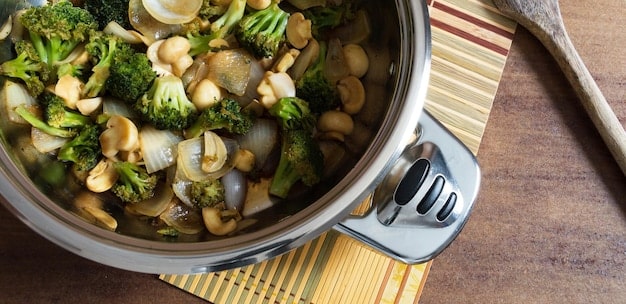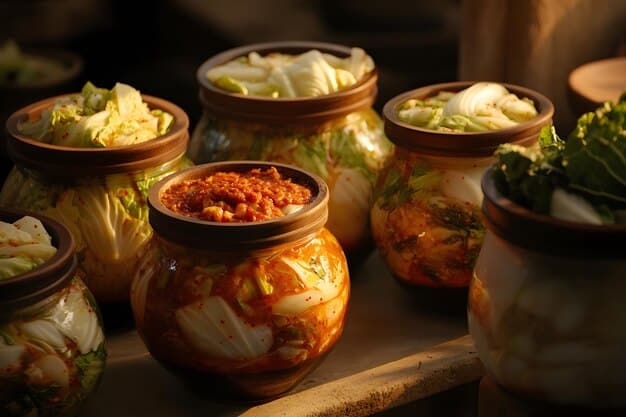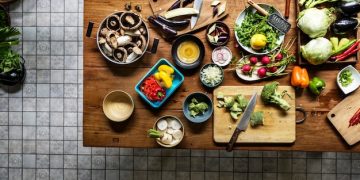Level Up Your Korean Cooking: Mastering Authentic Flavor Techniques

Level up your Korean cooking by mastering three advanced techniques: temple food-inspired vegetable broths, traditional fermentation methods, and intricate Korean sauce layering for authentic and complex flavors.
Ready to take your Korean cooking skills to the next level? Forget basic recipes; it’s time to delve into the authentic flavors of Korea. This guide will show you how to level up your Korean cooking with three advanced techniques that will transform your dishes from simple to sensational.
Unlock Authentic Korean Flavors: Advanced Cooking Techniques
Korean cuisine is more than just kimchi and bulgogi; it’s a rich tapestry of flavors developed over centuries. To truly master Korean cooking, it’s essential to move beyond basic recipes and embrace advanced techniques that unlock a depth of flavor that is both complex and deeply satisfying.
This article will explore three key techniques that will elevate your Korean cooking to a new level. Each technique is rooted in tradition and offers a unique approach to flavor development, allowing you to create authentic and unforgettable Korean dishes.
1. The Art of Temple Food-Inspired Vegetable Broths
In Korean temple cuisine, the emphasis is on maximizing the natural flavors of vegetables to create deeply flavorful and nourishing dishes. Vegetable broths are the foundation of many temple food recipes, providing a clean and complex flavor base without the use of meat or seafood. This technique is a secret weapon for level up your Korean cooking especially if you’re looking for vegetarian options.

Building a Flavorful Foundation
Traditionally, Korean vegetable broths are made using a combination of dried ingredients like:
- Dried shiitake mushrooms, renowned for their rich umami flavor.
- Kelp (dashima), which imparts a savory and slightly salty note.
- Daikon radish, offering a mild sweetness and subtle peppery undertones.
These ingredients are simmered together for an extended period, allowing their flavors to meld and create a complex and satisfying broth. You can experiment with other vegetables like onions, garlic, and ginger to add additional layers of flavor.
Beyond the Basics: Innovative Broth Combinations
While the traditional combination is a great starting point, feel free to experiment and create your own unique vegetable broth blends. Consider adding ingredients like:
- Dried persimmons for a touch of sweetness and subtle caramel notes.
- Dried apple slices for a bright and fruity flavor.
- Roasted corn husks for a smoky and earthy dimension.
- Rehydrated seaweeds (other than kelp) to increase the mineral content.
The key is to balance the flavors and create a broth that is both complex and harmonious. Don’t be afraid to try new combinations and discover your own signature broth.
By mastering temple food-inspired vegetable broths, you can create a versatile and flavorful foundation for a wide range of Korean dishes, from soups and stews to rice dishes and vegetable sides.
2. Mastering Traditional Fermentation Techniques
Fermentation is an integral part of Korean cuisine, and mastering traditional fermentation techniques is key to unlocking authentic and complex flavors. From kimchi to doenjang, fermented foods are not just condiments; they are nutritional powerhouses enriching the taste and depth of Korean dishes, helping you level up your Korean cooking.
Unveiling the Magic of Kimchi
Kimchi, Korea’s iconic fermented cabbage dish, is a testament to the power of fermentation. While there are countless variations, the basic process involves fermenting cabbage with a mixture of:
- Gochugaru (Korean chili powder) for spice and color.
- Jeotgal (fermented seafood) for umami and depth.
- Garlic and ginger for pungent aromatics.
The fermentation process not only preserves the cabbage but also creates a unique and complex flavor profile that is both spicy, tangy, and savory. Experimenting with different types of kimchi, such as kkakdugi (radish kimchi) or oi sobagi (cucumber kimchi), can expand your understanding of fermentation and its impact on flavor.
Exploring the World of Korean Jang (Sauces)
Korean cuisine relies heavily on fermented sauces known as “jang.” These sauces provide a foundation of flavor for many dishes and are essential for creating authentic Korean taste:
- Doenjang (fermented soybean paste) is a savory and earthy sauce with a robust flavor.
- Gochujang (fermented chili paste) is a spicy, sweet, and umami-rich sauce.
- Ganjang (soy sauce) comes in many varieties, from light and salty to dark and rich.
Homemade Doenjang: A Rewarding Experiment
Making your own doenjang can be a rewarding experience, although it requires patience and careful attention to detail. Here’s a simplified approach:
- Soak and cook soybeans until very soft.
- Mash the soybeans and form them into blocks (meju).
- Dry the meju under the sun until hardened.
- Ferment the meju in brine for several months, allowing beneficial bacteria to develop.
- Separate the solids (doenjang) from the liquid (ganjang).
You’ll taste the rich umami flavor, deep and complex after fermentation of making your own sauces at home.
By mastering the art of fermentation, you can unlock a world of complex and authentic Korean flavors. These fermented ingredients are not just condiments; they are essential building blocks for creating unforgettable Korean dishes.

3. Mastering Intricate Korean Sauce Layering
Korean sauces play a pivotal role in flavoring dishes beyond simple seasoning. The key is to understand how to layer these sauces to create depth and complexity, which is crucial to level up your Korean cooking. Traditional Korean cuisine orchestrates sauces by finely tuning the flavor profile for a balance of sweet, savory, spicy, and tangy components.
Blending Gochujang with Other Ingredients
Gochujang, the quintessential Korean chili paste, doesn’t stand alone. It’s often combined with other ingredients to create unique and nuanced flavor profiles. Some common combinations include:
- Gochujang + honey or sugar: To smooth out the spiciness and add sweetness in marinades for grilled meats or spicy stews.
- Gochujang + soy sauce: Enhances the savory side, ideal for braised dishes or dipping sauces.
- Gochujang + sesame oil: Adds a nutty, aromatic richness, perfect as a quick sauce for bibimbap.
Creating Balanced Braising Sauces
Braising is a famous cooking method in Korean cuisine, requiring sauces that tenderize and imbue ingredients with rich tastes. A well-balanced braising sauce might contain:
- Soy sauce provides the base umami and saltiness.
- Rice wine adds sweetness and helps tenderize the meat.
- Garlic and ginger balance with aromatic warmth.
- A touch of sugar balances and deepens the flavors.
The Art of the Dipping Sauce
Dipping sauce in korean cuisine can serve as the perfect counterbalance or complement to grilled items or savory pancakes, enabling dynamic flavor experiences.
- Ganjang (soy sauce) with vinegar: Simple yet effective for balancing richness.
- Cho-gochujang (vinegar gochujang): Great on seafood for freshness.
- Ssamjang (mixed dipping sauce): Combines doenjang, gochujang, garlic, onions, and sesame oil.
Mastering these techniques enhances the depth, making the cooking flavorful, distinct, and authentic. It’s a symphony of textures and sensations, achieving perfect balance with every bite.
| Key Point | Brief Description |
|---|---|
| 🌱 Vegetable Broths | Use dried shiitake mushrooms, kelp, and daikon radish for a rich, umami base. |
| 🌶️ Fermentation | Kimchi and jang (doenjang, gochujang) are essential for authentic Korean flavors. |
| 🥢 Sauce Layering | Combine gochujang with honey, soy sauce, or sesame oil for complex flavor. |
Frequently Asked Questions
▼
Temple food broths rely solely on vegetables and dried ingredients to create a rich umami flavor, avoiding meat or seafood. This clean foundation allows the natural flavors of the ingredients to shine.
▼
Kimchi fermentation time varies, but it typically takes between 3 days to several weeks at room temperature, then refrigerated. The longer it ferments, the tangier it becomes, so it’s about personal preference!
▼
Doenjang should be stored in an airtight container in the refrigerator. Properly stored Doenjang can last for years due to the natural preservatives created during the fermentation process.
▼
While you can use regular chili powder, it won’t provide the same flavor as gochugaru. Gochugaru has a unique fruity and slightly smoky flavor that is essential for authentic Korean cuisine.
▼
Dishes like braised short ribs (galbi jjim), spicy chicken stew (dakdoritang), and bibimbap all benefit greatly from the artful layering of Korean sauces. It adds depth and complexity to these dishes.
Conclusion
By mastering these three advanced techniques—vegetable-based broths inspired by temple cuisine, traditional fermentation practices, and strategic sauce layering—you can dramatically enhance your Korean cooking skills. Experiment with these methods to infuse your dishes with authentic, deep, and complex tastes, providing an impressive dining experience every time.





